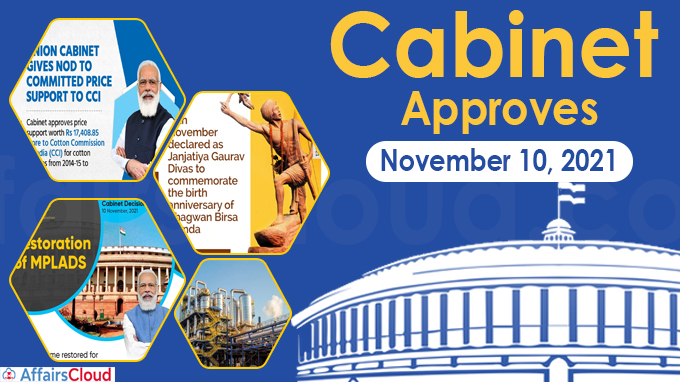
The Union Cabinet headed by Prime Minister (PM) Narendra Modi approved the following important initiatives on November 10, 2021.
- Declaration of November 15 as ‘Janjatiya Gaurav Divas’
- Restoration and Continuation of MPLADS
- Hike in Ethanol Price under Ethanol Supply Year 2021-22
- Committed Price Support of Rs 17,408.85 crore to CCI
- Reservation Norms for Use of Jute in Packaging
-Approved the declaration of November 15 as ‘Janjatiya Gaurav Divas’
On November 10, 2021, the Union Cabinet, chaired by the PM approved the declaration of November 15 as ‘Janjatiya Gaurav Divas’ to mark the birth anniversary of tribal leader and freedom fighter Sri Birsa Munda.Sri Birsa Munda is revered as “Bhagwan” by tribal communities.
- The day was also dedicated to several tribal communities such as Santhals, Tamars, Kols, Bhils, Khasis and Mizos, to honour their contributions to Indian history and culture.
- Birsa Munda fought against the British colonial system and spearheaded a movement against British oppression giving a call for ‘Ulgulan’ (Revolution).
Note – In 2016, the Government of India (GoI) sanctioned 10 tribal freedom fighter museums across India.
Week-long Celebration:
i.The GoI has planned week-long celebrations starting from 15th November to 22nd November 2021 to celebrate and commemorate 75 years of history of tribal people, culture and achievements.
ii.As part of the celebration, several activities have been planned jointly with State Governments. The events will display the unique tribal cultural heritage, their contributions in freedom struggle, practices, rights, traditions, cuisines, health, education and livelihood.
Key Points:
i.The day will be celebrated every year and would recognize the efforts of the tribals for preservation of cultural heritage and promotion of Indian values of valour, hospitality and national pride.
ii.The PM would inaugurate the Tribal Freedom Fighter Museum, which is being built at the jail complex (where Birsa Munda breathed his last) in Ranchi, Jharkhand at the cost of Rs 35 crore. It is designed based on Cellular jail in Andaman and Nicobar Islands.
-Approved the Restoration and Continuation of MPLADS
The Union Cabinet approved restoration and continuation of the Member of Parliament Local Area Development Scheme (MPLADS) during the remaining part of Financial Year 2021-22 and up to Financial Year 2025-26 co-terminus with the period of 15th Finance Commission which was suspended in April 2020 due to COVID-19.
- The GoI had suspended MPLADS during FY21 and FY22 to use the funds for managing health services and the adverse impact of the COVID-19 pandemic in India.
- Now, the scheme was restored for the remaining part of FY22 and for those period funds will be released at the rate of Rs 2 crore per MP in one instalment.
- The scheme will continue till FY26 i.e. from FY23 to FY26, funds will be released under MPLADS at the rate of Rs 5 crore per annum to each of the MPs in two instalments of Rs 2.5 crore each.
- The total financial implication for restoration and continuation of the MPLADS for the remaining part of the Financial Year 2021-22 and up to 2025-26 will be Rs. 17417.00 crore , viz – For 2021-22:1583.5 Crore ; For 2022-23:3965 Crore; For 2023-24 : 3958.50 Crore; For 2024-25 :3955 Crore; For 2025-26 : 3955 Crore.
About MPLADS:
i.The scheme was started in December 1993 to enable MPs to recommend District collectors for development programmes involving the expenditure of Rs 5 crore every year in their constituencies.
ii.MPLADS fund – Under MPLADS, an MP is entitled to get Rs. 5 crores annually for their constituency. The scheme is fully funded by GoI.
iii.Administration – The Ministry of Rural Development initially administered the scheme. Since October 1994 it has been transferred to the Ministry of Statistics and Programme Implementation.
iv.Since June 2016 MPLADS funds could be used for implementation of the schemes such as Swachh Bharat Abhiyan, Accessible India Campaign (Sugamya Bharat Abhiyan), conservation of water through rainwater harvesting and Sansad Aadarsh Gram Yojana etc.
-Approved Hike in Ethanol Price under Ethanol Supply Year 2021-22
Cabinet Committee on Economic Affairs (CCEA) chaired by PM approved for fixing higher ethanol prices derived from different sugarcane-based raw materials under the EBP (Ethanol Blended Petrol) Programme for the forthcoming sugar season 2021-22 during Ethanol Supply Year (ESY) 2021-22 from 1st December 2021 to 30th November 2022.
Approved Price rise:
i.The Price of ethanol from the C heavy molasses route was increased from Rs 45.69 per litre to Rs 46.66 per litre.
ii.The price of ethanol from the B heavy molasses route was increased from Rs 57.61 per litre to Rs 59.08 per litre.
iii.The price of ethanol from sugarcane juice, sugar/sugar syrup route was increased from Rs 62.65 per litre to Rs 63.45 per litre.
iv.Additionally, GST (Goods and Service Tax) and transportation charges are also made payable.
v.Government has provided the Oil PSEs (Public Sector Enterprises) with the freedom to decide the pricing for 2G ethanol, as it would help in setting up advanced biofuel refineries in India.
Note – The grain-based ethanol prices are currently being decided by Oil Marketing Companies (OMCs) only.
About EBP Programme and Key Initiatives:
i.It was launched in January 2003 by the Ministry of Petroleum & Natural Gas (MoP&NG) and was being implemented throughout India except for Union Territories of Andaman Nicobar and Lakshadweep islands.
- Under the programme, the Oil Marketing Companies (OMCs) sell petrol blended with 10 percent
What is Ethanol? It is an agro-based product, mainly produced from a by-product of the sugar industry, namely molasses.
ii.For the first time during 2018, the differential price of ethanol-based on raw material utilized for ethanol production was announced by the GoI.
iii.MoP&NG has also issued a ‘Long Term Ethanol Procurement Policy’ under EBP Programme in 2019 and directed OMCs to target 10 percent ethanol blending in petrol by the end of ESY 2021-22 and 20 percent by ESY 2025-26.
iv.On 5th June 2021 (on World Environment Day), the PM released the ‘Report of the Expert Committee on Road Map for ethanol blending in India 2020-2025’.
v.To restart the Second Generation (2G) ethanol programme (which can be produced from agricultural and forestry residues, e.g. rice & wheat straw/corn cobs & Stover/bagasse, woody biomass), a few projects are being set up by Oil PSEs by taking financial assistance from the Government’s ‘Pradhan Mantri JI-VAN Yojana’.
-Approved Committed Price Support of Rs 17,408.85 crore to CCI
The CCEA approved the committed price support of Rs 17,408.85 crore to the Cotton Corporation of India (CCI) for 7 cotton seasons from 2014-15 to 2020-21 (i.e. up to September 30, 2021). The cotton season lies between October-September.
Key Points:
i.Cotton is a cash crop and it plays a key role in sustaining the livelihood of around 58 lakh cotton farmers and 400 to 500 lakh people who are engaged in cotton processing and trade.
ii.The area under cotton cultivation during cotton season 202-21 was 133 lakh hectares with an estimated production of 360 lakh bales, which account for around 25 percent of total global cotton production.
iii.CCI and authorised agencies procured 123 lakh cotton bales in 2019-20 and 100 lakh bales in 2020-21 and the annual production is estimated at 350-360 lakh bales.
iv.In the last two cotton seasons (2019-20 and 2020-21), CCI procured around 1/3rd of the cotton production in the country and disbursed more than Rs 55,000/- crore directly in the bank accounts of around 40 lakh farmers.
v.GoI appoints CCI as Central Nodal Agency to undertake MSP (Minimum Support Price) in cotton by procuring all FAQ (Fair Average Quality) grade cotton from farmers without any quantitative ceiling, as and when cotton prices fall below MSP level.
- There are 11 major cotton-growing states in India.
-Approved Reservation Norms for Use of Jute in Packaging
Cabinet has approved reservation norms under the Jute Packaging Material Act (JPM Act) for making mandatory use of jute in packaging for the Jute Year 2021-22 (1st July 2021 to 30th June, 2022).
- As per the reservation norms, 100 percent food grains and 20 percent of sugar were mandated to be packed in jute bags during Jute Year 2021-22.
- The reservation norms provide for direct employment to 3.7 lakh workers and 40 lakh farmers in the Jute Sector.
Key Points:
i.JPM Act, 1987 protects the interest of Jute farmers, workers and persons who are engaged in jute goods’ production.
ii.75 percent of the total production of the Jute Industry is Jute Sacking Bags of which 90 percent is supplied to the Food Corporation of India (FCI) and State Procurement Agencies (SPAs).
iii.Every year GoI purchases Jute sacking bags worth ~Rs 8,000 Crore for packing of food grains. The average Production of Jute Sacking Bags is about 30 lakhs bales (9 lakh MT).
iv.The Jute industry occupies an important place in the Indian economy and it is one of the major industries in the eastern region i.e. in West Bengal, Bihar, Odisha, Assam, Tripura, Meghalaya, Andhra Pradesh and Telangana.
Recent Related News:
In September 2021, the government approved the continuation of the National Export Insurance Account (NEIA) scheme with the contribution of Grant-in-aid of Rs 1,650 Crore over a period of 5 years, i.e. from FY22 to FY26.
The cabinet has approved the doubling of the Nimach-Ratlam railway line in Madhya Pradesh at a total estimated cost of Rs 1,095.88 crore and the completion cost is Rs 1,184.67 crore.
About Ministry of Textiles:
Union Minister – Piyush Goyal (Constituency – Maharashtra)
Minister of State – Darshana Vikram Jardosh (Constituency – Surat, Gujarat)




